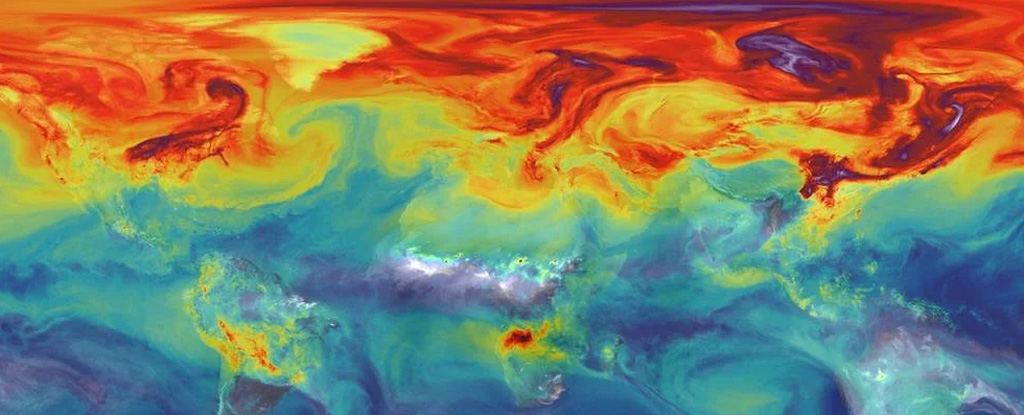In 2013 the National Oceanic and Atmospheric Administration (NOAA) reported that atmospheric concentrations of carbon dioxide (CO2) had reached 400 parts per million (ppm) for the first time since the Pliocene (about 3 million years ago).
According to IPCC Sixth Assessment Report (AR6) “Excess carbon dioxide” in our atmosphere will result in an increase in average global temperature of between 1.5 and 2°C by 2030.
This will significantly affect ecosystems worldwide, including species extinction, droughts, wildfires, extreme weather conditions and crop failures.
In addition to curbing emissions, these changes require mitigation and adaptation strategies and climate monitoring. This is the purpose of NASA’s Orbiting Carbon Observatory (OCO) 2 and 3 missions, twin satellites that make space-based observations of CO2 in the Earth’s atmosphere to understand the properties climate change better.
Use of the fifth largest coal-fired power plant in the world as a test casea team of researchers used data from OCO 2 and 3 to detect and track changes in CO2 and quantify the emissions produced below.
The research was led by Ray Nassar, a senior researcher at Environment and Climate Change Canada (ECCC) and Associate Professor at the University of Toronto (UofT). He was assisted by researchers from ECCC, UofT, Colorado State University and NASA’s Jet Propulsion Laboratory (JPL).
The paper describing their findings was published in October 28, 2022 Frontiers in remote sensing.
Their results show that space-based observations can be used to track CO2 Emission changes at local level.
Introduced in 2014, the OCO-2 satellite Maps natural and anthropogenic CO2 emissions at regional and continental level. This is done indirectly by measuring the intensity of sunlight reflected from the Earth’s surface and directly by measuring the amount of CO2 absorbed in the air column between the surface and the satellite.
The OCO-2 satellite also has spectrometers calibrated to detect CO’s specific signature2 Gas. Its companion (OCO-3) was built using OCO-2’s spare parts and released to the market International Space Station (ISS) in 2019.
This instrument includes a mapping mode that can make comprehensive observations over entire areas, allowing researchers to use OCO-3 to create detailed mini-maps of large cities – where excess carbon emissions are concentrated.
Using data collected from multiple flyovers between 2017 and 2022, the research team analyzed emissions from the largest single source of emissions in Europe – the Belchatów Power Plant in Poland.
From this they recognized changes in the CO2 Levels that corresponded to the hourly fluctuations in the plant’s power production.
The Belchatów power plant has been in operation since 1988 and will remain open (according to the Polish government) until the end of 2036. It is currently the largest coal-fired power plant in the world (with a reported capacity of 5,102 megawatts).
Lignite (lignite) is used, which typically produces higher emissions per megawatt than bituminous coal (anthracite). Large facilities such as power stations and oil refineries are no longer required about half of global carbon emissions from fossil fuels.
None of the satellites were originally designed to capture emissions from specific individual facilities such as Belchatów.
At a NASA press releaseAbhishek Chatterjee, OCO-3 mission project scientist, explained how this made their findings a “pleasant surprise” and how he and his colleagues look forward to future research opportunities:
“As a community, we are refining the tools and techniques to extract more information from the data than we originally planned. We are learning that we can actually understand much more about anthropogenic emissions than we previously anticipated. It’s really exciting to think that we’ll have another five to six years of operation with OCO-3. We see that taking measurements at the right time and at the right scale is crucial.”
According to Nasser, most are CO2 Emission reports are generated from estimates or data collected at the Earth’s surface. This consists of considering the mass of fossil fuels used, calculating the expected emissions and generally does not include atmospheric measurements.
said Nasser: “The finer details of exactly when and where emissions occur are often not available. Providing a more detailed picture of carbon emissions could help track the effectiveness of measures to reduce emissions. Our approach with OCO-2 and OCO-3 can be applied to more power plants or modified for carbon emissions from cities or countries.
In the future, climate scientists will benefit from the mapping method of OCO-3’s observations, which could serve as “pathfinders” for next-generation satellite missions. NASA recently announced that OCO-3 mission operations aboard the ISS would be extended by several years.
The instrument will operate in parallel with another greenhouse gas observation mission, the Investigation of the mineral dust source at the earth’s surface (EMIT).
These and other efforts to monitor climate change and CO2 -Real-time emissions will prove invaluable to mitigation and adaptation efforts.
This article was originally published by universe today. read this original article.





